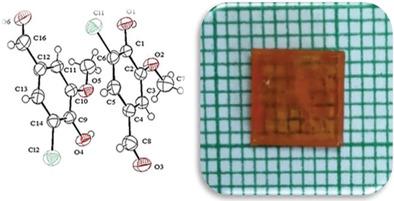当前位置:
X-MOL 学术
›
Cryst. Res. Technol.
›
论文详情
Our official English website, www.x-mol.net, welcomes your
feedback! (Note: you will need to create a separate account there.)
Facile Synthesis, Crystal Structure, Spectral Characterization, Quantum Chemical Calculations, and Hirshfeld Surface Analysis of 5-Chloro-3-Methoxy-4-Hydroxybenzaldehyde
Crystal Research and Technology ( IF 1.5 ) Pub Date : 2021-06-04 , DOI: 10.1002/crat.202100017 P. Nagapandiselvi 1
Crystal Research and Technology ( IF 1.5 ) Pub Date : 2021-06-04 , DOI: 10.1002/crat.202100017 P. Nagapandiselvi 1
Affiliation

|
This article deals with synthesis, growth, structure, and characterization of 5-chloro-3-methoxy-4-hydroxybenzaldehyde (5CMHBA or 5-chlorovanillin) single crystals. A facile one-pot method is employed for the chlorination of vanillin using N-chlorosuccinimide. After chlorination, the single crystals of 5CMHBA are grown by slow evaporation solution growth technique. Grown crystals are subjected to single crystal X-ray diffraction (SXRD), Fourier Transform Infrared (FTIR), and Thermogravimetric-Differential Thermal Analysis (TG-DTA). 5CMHBA crystallizes in the tetragonal crystal system with the space group P42/n. Vibrational characteristics are studied using FTIR. Further, thermal studies of the crystal are carried out using simultaneous TG-DTA thermal analyzer. The molecular structure and its intermolecular interactions are studied by applying time–dependent density functional theory (TD-DFT) using Gaussian 09 program and Hirshfeld surface analysis. A lesser energy gap of the 5CMHBA compared to that of vanillin shows the high reactivity of the molecule. Dipole moment, polarizability, and hyper-polarizability are calculated in the molecular level and found to have greater polarizability than vanillin and also higher in order than that of standard urea molecule. This reveals the suitability of the molecule for nonlinear optical applications. The intermolecular interactions and porosity are analyzed and compared with vanillin and its polymorphs by Hirshfeld surface analysis.
中文翻译:

5-Chloro-3-Methoxy-4-Hydroxybenzaldehyde 的简易合成、晶体结构、光谱表征、量子化学计算和 Hirshfeld 表面分析
本文涉及 5-氯-3-甲氧基-4-羟基苯甲醛(5CMHBA 或 5-氯香草醛)单晶的合成、生长、结构和表征。一种简便的一锅法用于使用N-氯代琥珀酰亚胺氯化香草醛。氯化后,通过缓慢蒸发溶液生长技术生长5CMHBA单晶。对生长的晶体进行单晶 X 射线衍射 (SXRD)、傅里叶变换红外 (FTIR) 和热重-差热分析 (TG-DTA)。5CMHBA 在四方晶系中结晶,空间群为 P4 2/n。使用 FTIR 研究振动特性。此外,晶体的热研究是使用同步 TG-DTA 热分析仪进行的。使用高斯 09 程序和 Hirshfeld 表面分析,通过应用时间相关密度泛函理论 (TD-DFT) 来研究分子结构及其分子间相互作用。与香草醛相比,5CMHBA 的能隙更小,表明该分子的高反应性。从分子水平计算偶极矩、极化率和超极化率,发现极化率比香草醛大,也比标准尿素分子高。这揭示了该分子对于非线性光学应用的适用性。
更新日期:2021-06-04
中文翻译:

5-Chloro-3-Methoxy-4-Hydroxybenzaldehyde 的简易合成、晶体结构、光谱表征、量子化学计算和 Hirshfeld 表面分析
本文涉及 5-氯-3-甲氧基-4-羟基苯甲醛(5CMHBA 或 5-氯香草醛)单晶的合成、生长、结构和表征。一种简便的一锅法用于使用N-氯代琥珀酰亚胺氯化香草醛。氯化后,通过缓慢蒸发溶液生长技术生长5CMHBA单晶。对生长的晶体进行单晶 X 射线衍射 (SXRD)、傅里叶变换红外 (FTIR) 和热重-差热分析 (TG-DTA)。5CMHBA 在四方晶系中结晶,空间群为 P4 2/n。使用 FTIR 研究振动特性。此外,晶体的热研究是使用同步 TG-DTA 热分析仪进行的。使用高斯 09 程序和 Hirshfeld 表面分析,通过应用时间相关密度泛函理论 (TD-DFT) 来研究分子结构及其分子间相互作用。与香草醛相比,5CMHBA 的能隙更小,表明该分子的高反应性。从分子水平计算偶极矩、极化率和超极化率,发现极化率比香草醛大,也比标准尿素分子高。这揭示了该分子对于非线性光学应用的适用性。







































 京公网安备 11010802027423号
京公网安备 11010802027423号